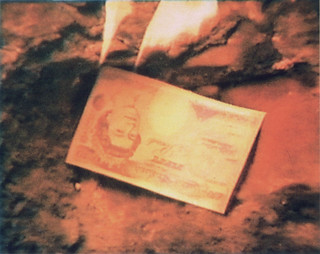
PREV ARTICLE
NEXT ARTICLE
FULL ISSUE
PREV FULL ISSUE
ARTISTS USING MONEY AS A METAPHORWe've often discussed the work of "money artists" such as J.S.G Boggs, Mark Wagner and others. Andy Warhol , Marcel Duchamp and others before them also explored this territory. Here's an excerpt from a March 24, 2020 ARTnews piece, "A History of Artists Using Money as a Metaphor—and a Medium in Their Work". -Editor
Call it Money Art. In 1939, critic Clement Greenberg argued that the avant-garde was connected to the ruling class of society by an "umbilical cord of gold." Money Art often focuses on that cord with a gimlet eye. In a time defined by the commodification of art—recently minted paintings showing up on the auction block, seven-figure prices for artists barely 30 years old—Money Art questions the churning operation of the art industry. It harnesses streams of cash for new ends and lets viewers see finance operating with often startling clarity. Damien Hirst's diamond-bedecked skull, For the Love of God (2007), is classic Money Art, since its price tag—a cool £50 million, or about $100 million at the time—is a key component of the piece. (Not to mention its markup from the reported £12 million spent to make it.) Richard Prince's more aggressively appropriative works—like those reproducing with only minor alterations the work of professional photographers—also count, given that part of their menacing appeal owes to the looming sense that they are backed by a willingness to litigate at length (another form of burning money). So, too, are certain new cost-intensive sculptures by Jeff Koons, whose financial structures—as documented in recent lawsuits—have the intricacy of real estate deals. While the more splashy, crass works of Money Art grab headlines, a whole secret history of 20th-century art can be written about more nuanced and oblique approaches to the form. These are works that consider and challenge the ways that money operates in contemporary society as a source and symbol of power and shame, and as a tool for exchange. As with movements of so many other kinds, Marcel Duchamp is a pillar of Money Art. For his 1924 work Monte Carlo Bond he advertised a series of bonds by which he claimed he would exploit a system he had developed to make money while at the roulette wheel in Monaco. The details of the enterprise are hazy, but he reported to friends that, over countless hours of spinning, "I'm neither ruined nor a millionaire and will never be either one or the other." That's about all that most artists hope for, at the end of the day. To read the complete article, see:
Wayne Homren, Editor The Numismatic Bibliomania Society is a non-profit organization promoting numismatic literature. See our web site at coinbooks.org. To submit items for publication in The E-Sylum, write to the Editor at this address: whomren@gmail.com To subscribe go to: https://my.binhost.com/lists/listinfo/esylum All Rights Reserved. NBS Home Page Contact the NBS webmaster 
|
